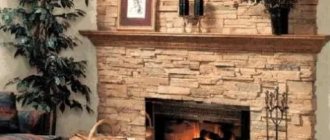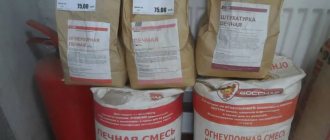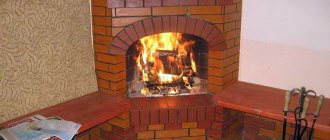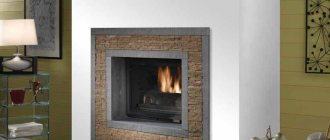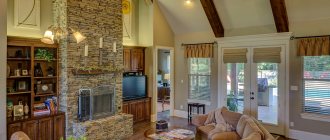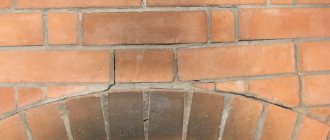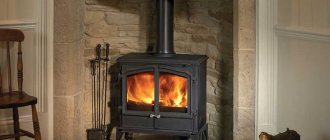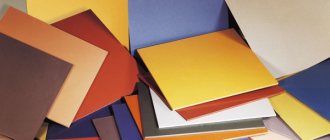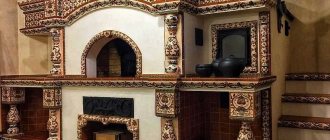In order for the fireplace to take its rightful central place in the house, you need to seriously think about its decoration. After all, he should attract household members with his beauty and comfort. But in addition to aesthetics, the fireplace lining must also have a practical component. An open fire in the hearth is not only comfort and luxury. But also danger. As well as soot and soot from combustion products.
Cladding a fireplace with tiles Source ceramicadecor.ru
Choosing a finishing method
Just the mention of a fireplace in a casual conversation can make a person feel warm. And all because an island of comfort with tongues of living flame immediately appears before your eyes. Where it is very pleasant to while away the cold winter evenings.
Previously, it was believed that only owners of private houses could afford such luxury. Since safety requirements are fully implemented only in such buildings. But with the advent of imitations, electric fireplaces and bio-fireplaces, it became possible to create a comfortable place to relax in any apartment in a multi-storey building.
Moreover, both a real working fireplace and a decorative stylization for it are subject to cladding. And if in ancient times only tiles were used to decorate the hearth, today the choice of materials is truly enormous. Therefore, the developer will involuntarily have to rack his brains about how to veneer the fireplace.
Since the range is really large, it is extremely difficult to name the ideal material. After all, in addition to aesthetics, it is necessary to pay attention to the practical side. Find out how well the chosen option suits the existing design. Because you will need to take into account a lot of factors.
Fireplace in the living room Source ceramicadecor.ru
For example, the type of fireplace and type of fuel. If wood burns in a real hearth, its walls will heat up to very high temperatures. Therefore, a special cladding is needed - heat-resistant. And it’s best to take the material with a margin to spare. Suddenly you want to heat the hearth with coal. And its combustion temperature is higher than that of firewood.
Or provide conditions at the location. It happens that a fireplace is installed on the terrace and used occasionally. The rest of the time the fireplace is in a cold room, where the ambient temperature can drop below zero. It goes without saying that the finishing material must be frost-resistant.
Any combustion releases products such as soot and soot. They settle on the surface and not only spoil the appearance of the room. If you want to lean your elbows on the mantelpiece, then this is fraught with damage to your clothes. Not to mention that you will have to wash it very carefully afterwards. Therefore, we need a cladding that is not afraid of water and is easy to clean regularly.
Fireplace lined with clinker tiles Source festima.ru
You also need to select a material that will fit perfectly into the overall design of the room. After all, no one has canceled simple design rules. And even if you involuntarily disturb the interior, then from the main accent of the room, the fireplace will literally turn into an eyesore.
But most often you have to take into account the weight of the materials. After all, finishing a fireplace with porcelain stoneware is completely impossible if it is a decorative imitation made of cardboard. And not every active fireplace can be covered with natural stone. The significant weight of these materials requires the construction of a reinforced foundation for the structure.
True, such difficulties await only those who want to decorate their recreation area with special luxury. But artificial stone or tiles are light enough to be glued even to a plasterboard frame. And the price will be much cheaper than natural materials.
And if you opt for plaster, you can save even more. And almost any conditions will suit her. And you don’t have to worry about the location, since this material is not afraid of temperature changes.
Plaster on the fireplace Source austroflamm.lv
Advantages of using artificial material.
Finishing the fireplace stove with decorative stone looks fresh and modern, it looks beautiful in any interior.
Let's look at the main advantages of using this material:
- A structure that implies pliability and the ability to be handled comfortably.
- Simple fastening technique. But it is still recommended to entrust the installation process to specialists.
- A light weight.
- Diversity. The modern market offers a wide range of stones of various shapes, textures, and shades. This allows you to choose the ideal option for any interior.
- Great appearance. The ability to produce artificial stone allows you to repeat the most unusual and beautiful decors that imitate any surface
- Affordable price. Using natural textures can be a serious waste for the family budget. If you don’t yet have the opportunity to spend extra money on finishing, choose an affordable alternative.
Plaster
The method is considered the simplest, and also budget-friendly, since the raw materials and tools needed are not expensive. But meanwhile, sometimes the result exceeds all expectations. Because in addition to a smooth surface, you can also get a very beautiful textured one. And even put various designs on it.
Types of plaster
Compositions that were developed for brick stoves are suitable for fireplaces. And since the temperature regime of the latter is much higher, there are no problems. In addition, the manufacturer has already added all the necessary additives and additives to the dry mixture.
And those who like to do all the processes themselves need to be warned. Although the solution has only three components (clay, sand, lime), without gained experience it will not be possible to choose the correct proportions. The required fat content of the clay plays an important role, to which it is necessary to select the exact amount of sand.
Incorrectly mixed plaster cannot withstand strong heat and will immediately crack. Therefore, experiments will be very expensive. After all, after each unsuccessful kindling, the fireplace will have to be re-plastered, removing the old composition from the surface.
Classically plastered fireplace Source lg2.it
And the manufacturer offers two types of ready-made mixtures. The first composition is basic and is applied in a layer of up to 1 cm. The finishing mixture contains finely ground substances. It is layered with a thickness of only 3 mm onto a completely dry rough finish. The final layer can be left smooth or treated with techniques that will create different decorative textures on the surface.
See also: Catalog of companies that specialize in the design and installation of fireplaces and stoves
Application technology
They say that plastering stoves and fireplaces is no different from working with ordinary walls. In general terms this is true. But there is one caveat. Before applying the base composition, it is necessary to heat the fireplace a little so that its walls warm up to 60 °C. This must be done so that the brick acquires its “working” parameters.
Step-by-step finishing of a fireplace using plaster:
- The old cladding is removed. The walls are cleaned of lime, clay or paint down to the brick itself.
- The seams are deepened to a distance of 1 to 1.5 cm. This will increase the adhesion of the mortar to the wall.
- Any cracks found in the masonry are filled with a heat-resistant sealant that can withstand heat up to 800 °C.
Filling cracks with a special sealant Source saznworld.com
- At the final stage of preparation, use a long-haired brush to sweep away all dust from the surface.
- A relatively flat wall can be moistened with water and immediately plastered with the base composition.
- If the differences in the plane are large, then the wall is reinforced with a metal mesh with a small cell and beacons are installed.
When performing the last point, preliminary jointing is not required. The mesh is fixed to the wall with nails, which are driven into the seams. And under the hats they put on a washer whose dimensions are larger than the mesh cell. The solution is applied with a spatula, leveling the surface along the beacons.
You can begin working with the finishing solution only after the base solution has completely dried. To speed up the process, it is allowed to create a draft in the room. But lighting a fireplace is strictly prohibited.
Preparation of the solution
The solution is the most important element of the entire work. There are 3 options that are often used in work:
- Clay solution. Optimal for brick construction, withstands high temperatures when burning solid fuel. Will last a long time. An important characteristic is the fat content of the clay. The most primitive method of determining it is to check mechanical strength: roll balls from a composition with different ratios of sand and clay, dry completely, and drop each ball onto the floor. The one that will not break is taken as the basis for its composition. To ensure uniformity, the clay is passed through a sieve and kneaded by mixing with water. To achieve the required elasticity, sand and water are added. To mix the mixture, it is recommended to use a drill with a special attachment - this will ensure uniformity of the mass.
- Cement mortar. The composition is popular in use, but is afraid of prolonged thermal exposure - the seams may crack. For the solution, it is necessary to add sand, the amount depends on the brand of cement used. For example, for the M300 the ratio is 3:1. The solution is mixed using a drill. To avoid rapid shrinkage and to give elasticity to the solution, it is recommended to add a pinch of washing powder.
- Dry mixture. A ready-made purchase option, also suitable for finishing a decorative fireplace.
On a note!
It is better if the cladding is attached to the same mortar that was used for the main masonry.
Tiling
A couple of decades ago, many home craftsmen used ordinary ceramic tiles for facing the fireplace. And the result was very similar to a lottery. With a probability of 50%, after some time the glaze was covered with a network of tiny cracks.
Tiling a fireplace Source pechki.su
The appearance of the fireplace was hopelessly ruined. Moreover, it is not even possible to simply wash off the contamination. Although in those days there were special materials. For example, tiles. But they were expensive. True, even today good tiles for finishing a fireplace have a high price. But you always have to pay for quality and beauty.
Types of tiles
The main material for decorating fireplaces is terracotta. Literally translated, the word means “burnt earth (clay).” This ceramic becomes brown in color after pre-treatment in the kiln. There is no glazed layer, and the surface remains matte and slightly porous. The tile looks like burnt red brick.
But if you apply a pattern to terracotta and cover the tiles with glaze, you get majolica. The word is of Italian origin, since such technology was first used in this country in the fourteenth century. And after a couple of centuries, the production method was copied in Russia. And stove tiles are essentially the same majolica, but only of Russian origin.
Majolica on the fireplace Source timepad.ru
Porcelain tiles
Ceramic tiles have properties similar to refractory bricks. The similarity in structure allows the tiles to change sizes when heated, along with the material of the fireplace insert itself. At the same time, the glaze coating protects the tiles from the adverse effects of water and soot.
7 photos
Ceramic tiles can have different shapes and sizes. In stores there are products that are designed specifically for finishing work with protrusions, corners and shelves. The color scheme of terracotta tiles is similar to natural materials. It is easy to lay, so you do not need special tools when working with it. An ordinary grinder is suitable for adjusting and cutting elements.
How is tiling done?
The process of finishing with ceramic tiles consists of several steps:
- Initially, you should clean the top layer of the fireplace insert from whitewash, plaster or paint. Then the seams are expanded between the bricks by one centimeter, and the dust is removed with a brush;
- using fire-resistant mastic or clay solution, you need to seal and dry the uneven edges;
- if your portal has poor brickwork and the mortar layer is more than 5 millimeters thick, it is necessary to level the surface of the structure using a grinding machine;
- then you should light the fireplace. The bricks should heat up to 30 degrees;
- A primer is applied to the surface of the bricks. This solution reduces dusting, promotes good adhesion and even drying of the adhesive liquid. Typically, the primer takes a couple of hours to dry;
- finishing work with tiles should begin from the bottom. If necessary, protruding parts can be trimmed and sanded. If your project contains corner elements, they should be glued first;
- The glue is diluted according to the instructions on the box. Use a drill fitted with a hard wire attachment as this will effectively mix the solution;
- use a wooden spatula to apply the solution. After this, use a notched trowel to run over the surface and press the tile tightly. Glue several tiles at a time to keep the level and plumb under control. A plastic corner helps create equal distances between elements;
- It takes two days to dry the materials, after which the joints are grouted. As a grouting material, you can use special products or a clay solution with fine sand and dye;
- If your tile does not have an auxiliary protective layer, you can apply a fire-resistant varnish to its surface. It makes it easier to care for the facing material.
Stone cladding
Stone finishing of the fireplace is made from both natural materials and artificial analogues. Moreover, the latter are produced in the form of tiles. Therefore, the technology for their installation is no different. Yes, and natural stone for work is pre-cut into thin plates.
True, some types of stone still retain significant weight. In addition, elements often come in different configurations. And this complicates the installation process. It is necessary to first assemble the mosaic on the floor, and then transfer it to the surface of the fireplace. But otherwise, the technology for installing stone is no different from gluing tiles.
Cladding a fireplace with stone Source dompechey.ru
Decor features
Cladding a fireplace is one of the most important activities in order to make not just a heating device, but also add color to the room, decorate it in accordance with a certain style or idea. Finishing can be done using a variety of materials, the main thing is to decide on the options that are suitable for a particular case.
The best way to determine the facing material is the type of fireplace design and some of its features, among which are:
- property location;
- interior design of the premises;
- financial opportunities;
- features of finishing materials.
The fireplace can be either active and permanent, or artificial, made of plasterboard.
A false fireplace can be decorated using the following materials:
- marble tiles;
- fake diamond;
- ceramic tile;
- tiles;
- textured plaster;
- gypsum;
- mosaic;
- wooden elements.
14photos
Drywall is perfectly framed using MDF, which will decorate the device and allow it to function for a long time and fully. The use of tiles and marble will also fit well into the interior of the room. And the use of tiles, which are very similar to tiles, will add elegance to the design, lightness and color.
Less popular methods
It’s worth talking right away about decorating the fireplace with tiles. The method is quite old, but today it is very rarely used. Firstly, such finishing is possible only when constructing a fireplace. You cannot cover an already finished hearth with real tiles.
Secondly, the installation is so complicated that it requires a highly specialized specialist. Tiles are already a very expensive pleasure. And the involvement of a master in the work makes such a fireplace truly “golden”.
You can line the fireplace with brick. In this case, there are two ways. They take plastic molded ceramic bricks and lay out the external walls. In the second case, the main masonry is refined. The seams are deepened and cleared. Then they are filled with special compounds.
The brick itself is also subjected to various treatments. Hydrochloric acid solution for color saturation. And before that, each element is polished or chamfered. The complexity of such finishing is so great that not every stove maker will take on the job.
Brick in decoration
For those who do not know how to decorate a wood-burning fireplace, we offer one of the simplest solutions - brick.
If your fireplace already has standard brickwork, as an additional decoration, you can use special paint and varnish solutions, which not only make the appearance of the installation well-groomed and stylish, but also reliably protect the material itself from sudden temperature changes and significantly strengthen it, preventing all sorts of cracks may form.
Finishing fireplaces in the country
Finishing fireplaces with firewood
Finishing fireplaces with bricks
Brick joints can be additionally filled with mortar of any color.
Video description
The video will show how to line a fireplace with artificial stone:
But a fireplace trimmed with wood looks most original. Some might say that this is a complete violation of fire safety. But if you follow certain rules, you can get a chic fireplace for your living room in a classic style.
Firstly, it is necessary to select wood that will maintain its structure at periodically changing temperatures. And you only need to consider oak, hornbeam, maple or cherry. The density of other breeds is much worse.
Secondly, the material is generously treated with fire retardants. And even after this, it is necessary to move the wooden frame ten centimeters away from the bricks of the hearth. Only in this case will the heating of the wood not exceed permissible limits.
Thirdly, the firebox itself must be covered with a protective screen. To protect the tree from accidentally flying sparks from the hearth. And as a result, you can get an aesthetic finish from natural materials that will last for an extremely long time. Moreover, the type of cladding will not change over time.
How to properly unstitch seams?
To give the masonry a more natural and aesthetic appearance, the joints are completely filled with mortar. To perform jointing, it is better to use only branded jointing materials.
Do not use mixtures that are intended for laying tiles.
- To completely fill the seam, you can use a seam filling bag. You can do it quickly yourself, you just need to cut off 1 corner of a regular plastic bag, only the hole should be slightly smaller than the seam to be filled.
- Fill the bag with mortar (do not pour too much, the volume should fit in the palm of your hand), apply pressure and force the mortar into the seam. Try to avoid getting liquid on the front surface.
- We wait until the mortar in the seams begins to set, after which we need to remove its excess using a trowel and at the same time press it into the seam. Do not try to remove the sagging immediately after filling, you will only stain the front part.
- After removing the excess, you should finally clean the seams using a broom, which should be made of plant materials. Do not use solvents for cleaning.
- Jointing is an extremely important work process that completely prevents moisture from entering the surface. If moisture penetrates under the cladding, the surface may crack.
Briefly about the main thing
When choosing materials for cladding a fireplace, you first need to pay attention to their weight. Natural stone or porcelain tiles have a very large mass. Therefore, they are suitable only for a private house, in which it is possible to strengthen the foundation of an existing fireplace.
In all other cases, it is better to stick to tiles. It weighs little and is easy to attach to the surface of the fireplace with glue. Moreover, its range is so wide that there is an imitation of almost all natural materials. From natural stone to wood of any species.
Processing technology.
Before proceeding with the coating itself, it is necessary to properly process the plane. You can install it almost anywhere.
To ensure a high-quality implementation of the introductory stage, the masters take into account the following important points:
- When cladding with wood, you need to remember how strongly it absorbs moisture. To minimize exposure before finishing work, it is necessary to apply a reliable waterproofing compound to the wood. If a specialist works with concrete or metal, you can refuse the waterproofing layer.
- The second stage is the installation of a special mounting grid, which is fixed with self-tapping screws. It is recommended to close their caps with washers for maximum reliability. There should be a distance of 5 cm horizontally and 15 cm vertically between fasteners. Installing the mesh allows you to achieve even masonry.
- Next, the plaster is applied by a professional. The thinnest layer is 1 cm, but ideally the layer is created thicker.
- When the master works with a fireplace portal made of concrete or brick, space is allocated for laying artificial stone to eliminate possible errors.
- When placing shaped elements, a special solution is used that is resistant to high temperatures. It can be a mixture of fireclay and cement or clay.
It is important to know
- It is recommended to choose only heat-resistant stone for the fireplace. The same principle must be followed when choosing glue.
- The adhesive solution will not be able to withstand stones that are too large.
- Decorative stone cladding is carried out only on the side, and the upper part must be flat so that, for example, photographs and scented candles can be placed.
A fireplace lined with decorative stone will look great in combination with a variety of surfaces: wooden, rough, smooth and glass. Using artificial material, you can decorate the fireplace in various styles. If you want to achieve the effect of antiquity, you should choose a stone with a coarse-grained structure. Unusual relief and irregular shapes will help realize any idea and design solutions. This element will combine sophistication and elegance at the same time.
Useful tips
- To make the process of laying decorative stones easier, it is necessary to create a shape on paper or cardboard that is equal in size to the fireplace wall. It is used to pre-lay out the material in the required order. After this, everything is sequentially transferred to the fireplace.
- To create landmarks and interesting accents, it is better to start attaching stones with the largest ones.
- Small stones or fragments that appeared during the work are left for last. They can act as a material for sealing small seams and inaccuracies.
- If some kind of pattern will be created on the fireplace or the surface must be perfectly flat, then the tiles must be numbered. This will allow you to put them in the required place during the work and not get lost.
- In cases where the fireplace is large and it is necessary to maintain a certain distance between decorative stones, then hooks or crosses should be used. They will allow you to accurately maintain the width of the seams.
- To make caring for the stone easier, you should coat it with varnish. This will not only create an attractive wet stone effect, but will also extend its durability.
- To create a unified interior, facing material can be used to decorate not only the fireplace, but doorways, walls, niches, trim on mirrors and even furniture.
- The remains of the finishing stone can be used to create a decorative panel, a frame for a mirror or photographs. They will look most impressive in the same room where the fireplace is located.
